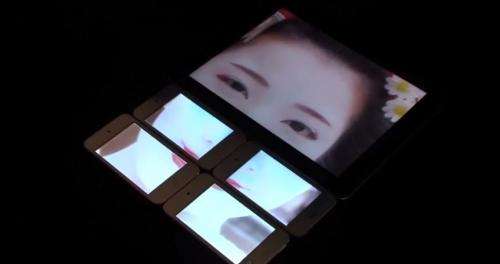November 2, 2012 report
Pinch interface can link displays of multiple screens (w/ Video)

(Phys.org)—A research group from Tokyo gives new meaning to the word pinch—newer than a notion of gripping two pieces of skin, or throwing a little salt into a stew, or, of course, referring to a multitouch gesture for touchscreens, but not only that. They have worked up a Pinch interface that puts the user into another display environment where screens serve as visual-display tiles, working together. Even if your smart device screens are of different sizes, the Pinch interface allows them to join forces, resulting in one single display, like a slick, if out of joint, tile puzzle.
Pinch is an interface that connects the displays from multiple touch devices and it is under development by a research group at the Tokyo University of Technology. When the user places a thumb and index finger on two adjacent screens and pinches, the screens link up. The screens can be lined up freely, vertical or horizontal. The connected devices share each other's position and screen size via Wi-Fi. Devices with different-sized screens, such as smartphones and tablets, can go together to form a display interface.
According to Takashi Ohta, Associate Professor at Tokyo University of Technology, who appeared in a video demo, "This Pinch interface we've developed is used to create applications that make devices react when they've both been pinched, so they work together. In the case of a graphics application, when the devices recognize they've been pinched, they can show the whole picture as if it's on one screen."
He said that Pinch can be the foundation of a musical experience, where you connect the different devices you have horizontally, with the result that "you could keep playing music for a long time."
Ohta sees Pinch as enabling "fun" communications, where people gather, place their devices next to one another, and communicate ideas and images in novel ways. Other avenues, too, could include mobile music, advertising, and photo-sharing experiences.
The Pinch team said it was offering Pinch to developers, hoping they could "do something with it."
In 2010, Ohta co-wrote a paper that cast some light on the present research. In that paper, titled "Automatic configuration of display ordering for multi-display environments," Ohta and Jun Tanaka said, "We designed and built a system that configures the information of how displays are arranged as a multi-display environment. The system automatically matches the physical location of displays and network addresses. It uses a web camera for capturing a real-time video to observe each display to flash its screens one by one. The timing and relative locations of the flashing screens are recognized using an image processing technique. Furthermore, the correspondence of the displays and the network addresses can be deduced from these data." The team concluded, based on their results, that the "system works perfectly, with various configurations of display dispositions."
© 2012 Phys.org




















